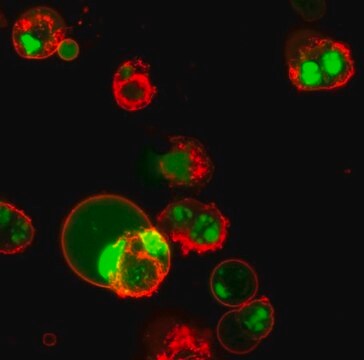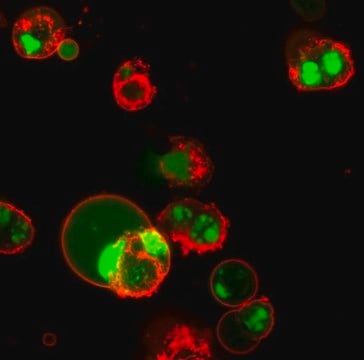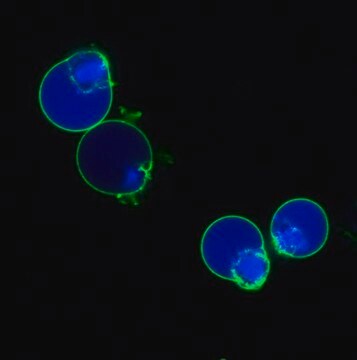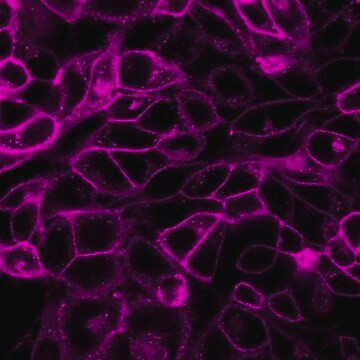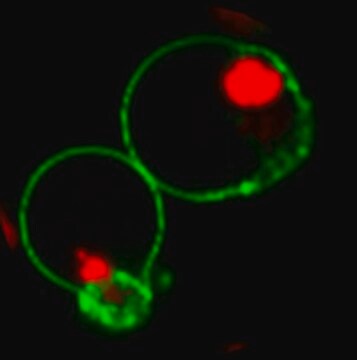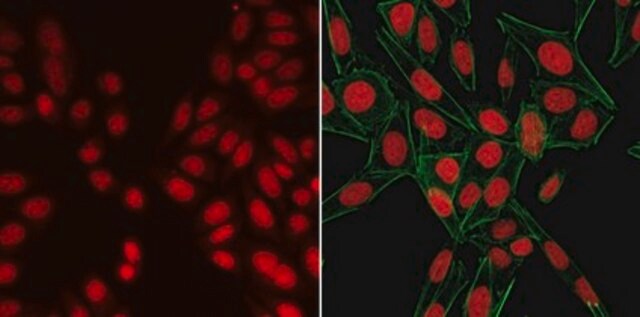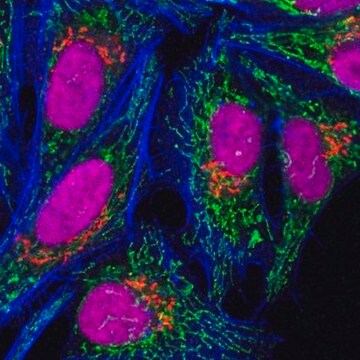SCT104
BioTracker NucView® 405 Blue Caspase-3 Dye (PBS)
Live cell imaging apoptosis dye for caspase-3/7 enzyme activity used to detect programmed cell death using fluorescence microscopy or flow cytometry applications.
Synonym(s):
Caspase-3/7 apoptosis dye, Live cell caspase-3 apoptosis probe, Live cell imaging probe
About This Item
Recommended Products
technique(s)
cell based assay: suitable
detection method
fluorometric
shipped in
ambient
General description
The BioTracker NucView 405 Blue Caspase-3 Dye provides a convenient live cell tool for profiling apoptotic cell populations based on caspase-3/7 activity using either fluorescence microscopy or flow cytometry. In contrast to other fluorogenic caspase substrates or fluorescent caspase inhibitor based (FLICA) assays, the BioTracker NucView 405 Caspase-3 Dye can be used to detect caspase-3/7 activity within individual intact cells without inhibiting apoptosis progression. The substrate consists of a fluorogenic DNA dye coupled to the caspase-3/7 DEVD recognition sequence. The substrate, which is initially non-fluorescent, penetrates the plasma membrane and enters the cytoplasm. In apoptotic cells, caspase-3/7 cleaves the substrate, releasing the high-affinity DNA dye, which migrates to the cell nucleus and stains DNA with bright blue fluorescence. Thus, NucView 405 Caspase-3 Substrate is bifunctional, allowing detection of caspase-3/7 activity and visualization of morphological changes in the nucleus during apoptosis. The dye is formaldehyde-fixable and compatible with subsequent immunostaining. The dye is offered in DMSO and PBS (phosphate-buffered saline) formulations. The substrate in PBS is formulated for use in cells that are sensitive to DMSO toxicity.
NucView 405 dye is excited by the 405nm laser line for detection by confocal microscopy in the DAPI channel, or by flow cytometry in the Pacific Blue channel. NucView 405 is ideal for caspase-3 detection in multi-color applications for researchers who wish to reserve the green fluorescence channel for other detection reagents.
Spectral Properties
Absorbance: 429nm
Emission: 469nm
Application
Cell Imaging
Live Cell Dye
Quality
Absorbance: 429nm
Emission: 469nm
Physical form
Storage and Stability
Note: Centrifuge vial briefly to collect contents at bottom of vial before opening.
Legal Information
Disclaimer
Storage Class Code
12 - Non Combustible Liquids
WGK
WGK 1
Flash Point(F)
does not flash
Flash Point(C)
does not flash
Regulatory Listings
Regulatory Listings are mainly provided for chemical products. Only limited information can be provided here for non-chemical products. No entry means none of the components are listed. It is the user’s obligation to ensure the safe and legal use of the product.
JAN Code
SCT104:
Certificates of Analysis (COA)
Search for Certificates of Analysis (COA) by entering the products Lot/Batch Number. Lot and Batch Numbers can be found on a product’s label following the words ‘Lot’ or ‘Batch’.
Already Own This Product?
Find documentation for the products that you have recently purchased in the Document Library.
Our team of scientists has experience in all areas of research including Life Science, Material Science, Chemical Synthesis, Chromatography, Analytical and many others.
Contact Technical Service